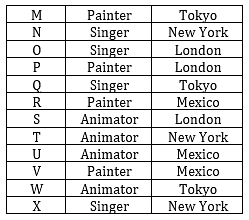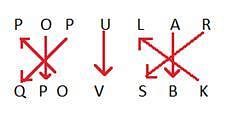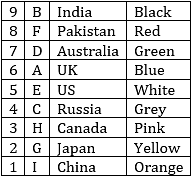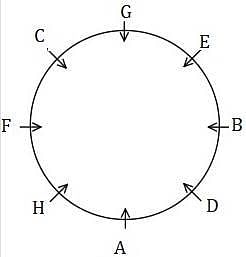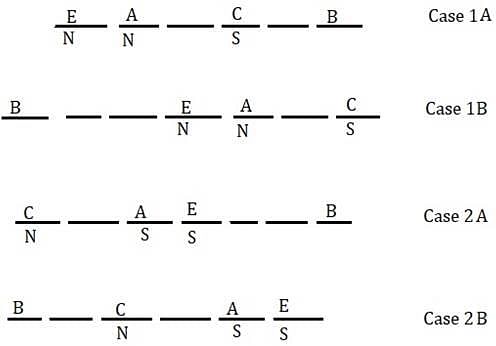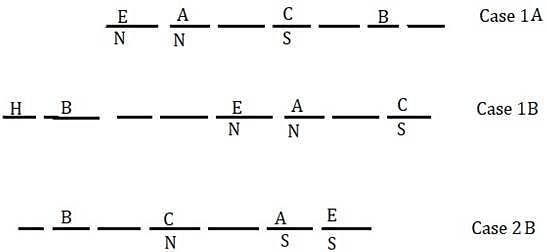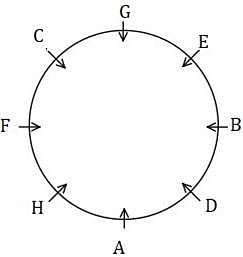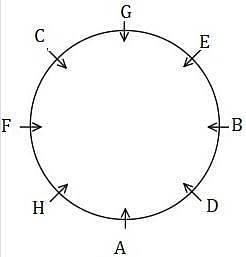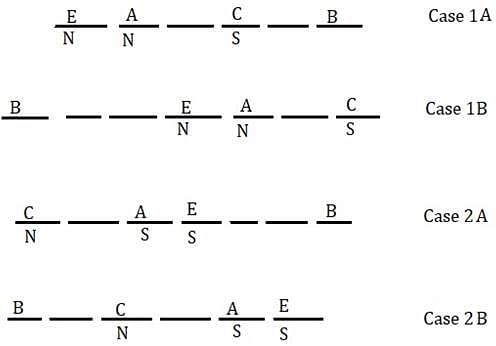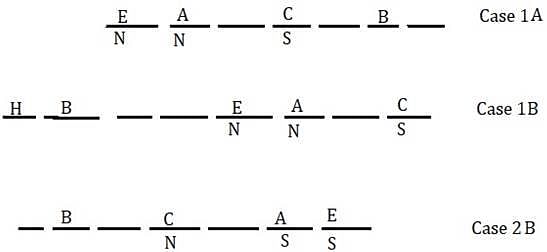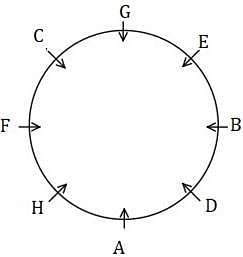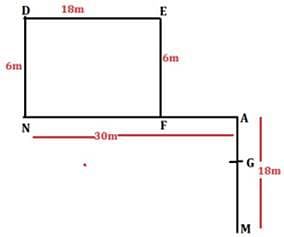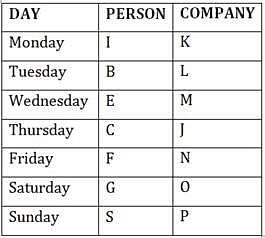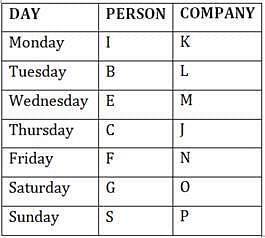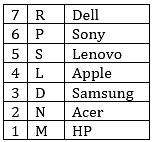Syndicate Bank PO Mock Test - 1 - Bank Exams MCQ
30 Questions MCQ Test Syndicate Bank PO Mock Test Series 2025 - Syndicate Bank PO Mock Test - 1
Direction: In the question symbols @, #,$, *, and % are used with different meaning as follows.
- 'A @ B' means 'A is not smaller than B.
- 'A # B' means 'A is neither smaller than nor equal to B’.
- 'A $ B' means 'A is neither greater than nor smaller than B.
- 'A * B’ means 'A is not greater than B’.
- 'A % B’ means 'A is neither greater than nor equal to B’.
In each of the following questions assuming the given statements to be true, find out which of the two conclusions I and II given below them is/are definitely true.
Statement:
N @ W, W # H, H % T
Conclusion:
I. H % N
II. T # W
Statement:
N @ W, W # H, H % T
Conclusion:
I. H % N
II. T # W
Direction: In the question symbols @, #,$, *, and % are used with different meaning as follows.
- 'A @ B' means 'A is not smaller than B.
- 'A # B' means 'A is neither smaller than nor equal to B’.
- 'A $ B' means 'A is neither greater than nor smaller than B.
- 'A * B’ means 'A is not greater than B’.
- 'A % B’ means 'A is neither greater than nor equal to B’.
In each of the following questions assuming the given statements to be true, find out which of the two conclusions I and II given below them is/are definitely true.
Statement:
J @K, K % M, M # T
Conclusion:
I. K %T
II. K@T
Statement:
J @K, K % M, M # T
Conclusion:
I. K %T
II. K@T
Direction: In the question symbols @, #,$, *, and % are used with different meaning as follows.
- 'A @ B' means 'A is not smaller than B.
- 'A # B' means 'A is neither smaller than nor equal to B’.
- 'A $ B' means 'A is neither greater than nor smaller than B.
- 'A * B’ means 'A is not greater than B’.
- 'A % B’ means 'A is neither greater than nor equal to B’.
In each of the following questions assuming the given statements to be true, find out which of the two conclusions I and II given below them is/are definitely true.
Statements:
L * P, P % V, V # D
Conclusions:
I. L * V
II. L $ D
Statements:
L * P, P % V, V # D
Conclusions:
I. L * V
II. L $ D
Direction: Study the information given below and answer the questions based on it.
12 people- M, N, O, P, Q, R, S, T, U, V, W and X, live in 4 different cities – London, New York, Mexico and Tokyo. Exactly 3 people live in each of the cities. Exactly 4 persons are Singer, Animator and Painter. M is not an Animator and does not live in New York or Mexico. N is a Singer and R is a Painter. P is a Painter who lives in London. Either U or S live in the same city as V. X who is a Singer lives in New York and W lives in Tokyo. T is an Animator who lives in New York. There are two Painters who live in Mexico and two singers who live in New York. All the Animators are living in different cities. All the persons from Tokyo have different professions. O and S both live in London. U & V are not Singers and both have different professions. Q is a Singer and does not live in New York. O is not an Animator. M and V have same professions.
Q. What is the profession and city of M?
Direction: Study the information given below and answer the questions based on it.
12 people- M, N, O, P, Q, R, S, T, U, V, W and X, live in 4 different cities – London, New York, Mexico and Tokyo. Exactly 3 people live in each of the cities. Exactly 4 persons are Singer, Animator and Painter. M is not an Animator and does not live in New York or Mexico. N is a Singer and R is a Painter. P is a Painter who lives in London. Either U or S live in the same city as V. X who is a Singer lives in New York and W lives in Tokyo. T is an Animator who lives in New York. There are two Painters who live in Mexico and two singers who live in New York. All the Animators are living in different cities. All the persons from Tokyo have different professions. O and S both live in London. U & V are not Singers and both have different professions. Q is a Singer and does not live in New York. O is not an Animator. M and V have same professions.
Q. The profession of U is?
Direction: Study the information given below and answer the questions based on it.
In a certain code,
- ‘za la ka ga’ is code for ‘must obey traffic rules’,
- “za fa sa na” is code for ‘we obey the elders’, ‘
- na la da sa’ is a code for ‘we must be elders’,
- ‘wa sa za da’ is code for ‘be elders obey younger’.
Q. Which of the following is the code for ‘elders’?
In a certain code POPULAR is written as QPOVSBK. How is SAMSUNG written in that code?
November 24, marks the anniversary of Heinrich Himmler to hide the Nazi genocide. With the Red Army practically at the gates Auschwitz, the largest of the Naziconcentration camps. Himmler chief verseer of the so-called Final Solution ordered the crematoriums at the camp destroyed and the killing of Jews throughout the Reich to cease. Himmler’s attempted cover-up failed miserably. Seventy years of trails, books, museums, testimonies and articles have so powerfully borne witness that one can only wonder whether there is anything at all left to say. The answer from all directions continues to be not only ‘yes’, but also ‘plenty’. For one thing, there's the fact that writers of stature continue to mine the signature horror of the 20th century. Today's prominent example is British novelist Martin Amis, who grappled with the Nazi genocide in earlier fiction too. Amis’s new book, The Zone of Interest, a satire set in a fictionalized version of Auschwitz. The novel becomes the object of impassioned - largely positive- reviews in both the U.S. and Europe.
Q. Which of the following conclusions can most properly be drawn from the information above?
Direction: Study the information given below and answer the questions based on it.
Nine people A, B, C, D, E, F, G, H and I, stay in a building. The building has nine floors and only one person stays on one floor. Each of them likes different colors namely-Red, Green, Blue, Black, Yellow, Pink, Orange, White and Grey. Each person belongs to different countries, i.e. India, Canada, US, UK, Pakistan, China, Japan, Russia and Australia, but not necessarily in the same order. The ground floor is numbered 1, the floor above it is numbered 2, and so on, and the topmost floor is numbered 9.
The one who belongs to Russia stays on the 4th floor. There are 4 floors between the floors on which D & G stay with D living above G. C stays on the floor immediately above H's floor. The one who likes Red stays on an even numbered floor and is a neighbor of the one who likes Green. I does not belong to Canada. The one who belongs to India stays on the topmost floor. The one who likes Orange stays immediately below the one who likes Yellow. E likes White. F belongs to Pakistan and stays on 8th floor.
There are 3 persons between the one who likes Black and the one who like White. There are two floors between the floors on which people from Australia and Russia stay. E stays immediately below the floor on which the person from UK lives. The person who likes Pink belongs to Canada and stays on an odd numbered floor. I stays on the bottommost floor. The person who likes Blue is from UK and stays on 6th floor. The person from Japan stays on 2nd floor. The persons from China and Canada are not the neighbors of the person from UK. D likes Green and G does not like Red. B does not live below the floor of A.
Q. How many floors are there in between the person D and the person who likes Orange lives is?
Direction: Study the information given below and answer the questions based on it.
Nine people A, B, C, D, E, F, G, H and I, stay in a building. The building has nine floors and only one person stays on one floor. Each of them likes different colors namely-Red, Green, Blue, Black, Yellow, Pink, Orange, White and Grey. Each person belongs to different countries, i.e. India, Canada, US, UK, Pakistan, China, Japan, Russia and Australia, but not necessarily in the same order. The ground floor is numbered 1, the floor above it is numbered 2, and so on, and the topmost floor is numbered 9.
The one who belongs to Russia stays on the 4th floor. There are 4 floors between the floors on which D & G stay with D living above G. C stays on the floor immediately above H's floor. The one who likes Red stays on an even numbered floor and is a neighbor of the one who likes Green. I does not belong to Canada. The one who belongs to India stays on the topmost floor. The one who likes Orange stays immediately below the one who likes Yellow. E likes White. F belongs to Pakistan and stays on 8th floor.
There are 3 persons between the one who likes Black and the one who like White. There are two floors between the floors on which people from Australia and Russia stay. E stays immediately below the floor on which the person from UK lives. The person who likes Pink belongs to Canada and stays on an odd numbered floor. I stays on the bottommost floor. The person who likes Blue is from UK and stays on 6th floor. The person from Japan stays on 2nd floor. The persons from China and Canada are not the neighbors of the person from UK. D likes Green and G does not like Red. B does not live below the floor of A.
Q. Four of the following are alike in a certain way and hence form a group. Which of the following does not belong to that group?
Direction: In question below is given a statement followed by assumptions. An assumption is something supposed or taken for granted. You have to consider the statement and the following assumptions and decide which of the assumptions is implicit in the statement.
Statement: The mind is the source of all human actions, yet the body is given more importance.
Assumptions:
I. The Mind is not given proper importance.
II. The Body is getting undeserved importance.
III. Every action starts from the brain.
Direction: In question below is given a statement followed by two courses of action numbered I and II. You have to assume everything in the statement to be true and on the basis of the information given in the statement. Decide which of the suggested courses of action logically follow(s) for pursuing.
Statement:
Despite high tax rate, in India there is a great problem of securing adequate revenues through taxation and public borrowing.
Course of Action:
1). Encourage people to opt for higher education and professional courses. This would enable them to come out of poverty trap. An increase in their earning would result in increased collection in the form of direct and indirect taxation.
2). Compared to all developed/developing countries, tax rates in India are quite rational. Its just that there's no culture of paying your taxes honestly and all other countries have better/stricter tax administration.
Direction: In the following question, two statements numbered I and II are given. There may be cause and effect relationship between the two statements. These two statement may be the effect of the same cause or independent causes. These statements may be independent causes without having any relationship. Read both the statements and decide which of the following answer choice correctly depicts the relationship between these two statements.
I. The Meteorological Department has issued a statement mentioning deficient rainfall during monsoon in many parts of the country.
II. The Government has lowered the revised estimated GDP growth from the level of earlier estimates.
Direction: Study the information given below and answer the questions based on it.
Eight persons A, B, C, D, E, F, G and H are sitting in a circular and facing the centre and then after some time they sit in a straight line some of them are facing north and some of them are facing south. C is 3rd to the left of A in circular and 2nd to the right of A in line. Three persons are sitting between A and B in line. A and C are facing different directions. C and G are neighbors in both arrangements and neither of them is at any ends in line. B is facing opposite to F in circular and F is facing south in line. F is 2nd to the right of G in circular. One of the neighbors of A in linear is 3rd to the right of A in circular. C is 3rd to the right of E in linear. E is not neighbor of A in circular and B in linear. H sits one of the ends but not neighbor of C in linear. D is 2nd to the right of F in linear. Not more than two persons sit between G and F in line. At least one person sits between D and H in line. D is not neighbor of F in circular. B’s neighbors are facing same directions and C’s neighbors are facing different directions in line. Not more than 4 persons are facing south.
Q. Who among the following is 3rd to the right of H in circular arrangement?
Direction: Study the information given below and answer the questions based on it.
Eight persons A, B, C, D, E, F, G and H are sitting in a circular and facing the centre and then after some time they sit in a straight line some of them are facing north and some of them are facing south. C is 3rd to the left of A in circular and 2nd to the right of A in line. Three persons are sitting between A and B in line. A and C are facing different directions. C and G are neighbors in both arrangements and neither of them is at any ends in line. B is facing opposite to F in circular and F is facing south in line. F is 2nd to the right of G in circular. One of the neighbors of A in linear is 3rd to the right of A in circular. C is 3rd to the right of E in linear. E is not neighbor of A in circular and B in linear. H sits one of the ends but not neighbor of C in linear. D is 2nd to the right of F in linear. Not more than two persons sit between G and F in line. At least one person sits between D and H in line. D is not neighbor of F in circular. B’s neighbors are facing same directions and C’s neighbors are facing different directions in line. Not more than 4 persons are facing south.
Q. Who among the following is 2nd to the left of H in straight line?
Direction: Study the information given below and answer the questions based on it.
Point A is 18m north of point M. Point N is 30m west of point A. Point D is 6m north of point N. Point D is 18m west of point E and point F is 6m south of point E. G lies 13m to the north of point M.
If a person wants to travel from point G to point F in a straight line i.e. without taking any turns, how much distance he has to travel to reach his destination?
Direction: A word and number arrangement machine when given an input line of words and numbers rearranges them following a particular rule in each step. The following is an illustration of input and rearrangement.
Input: join points 12 26 closed help 11 29 contest 17 team 27
- Step I: contest join points 12 26 closed help 11 17 team 27 29
- Step II: points contest join 12 26 closed help 11 team 27 29 17
- Step III: help points contest join 12 26 closed 11 team 29 17 27
- Step IV: join help points contest 12 closed 11 team 29 17 27 26
- Step V: team join help points contest closed 11 29 17 27 26 12
- Step VI: closed team join help points contest 29 17 27 26 12 11
- Step VI is the last step of the above input, as the desired arrangement is obtained.
As per the rule followed in the above steps, find out in each of the following questions the appropriate step for the given input.
Input: winner 22 26 ready window 16 dream 81 previous 17 pen 13
Q. What is the position of ‘previous’ in the 3rd step?
Direction: A word and number arrangement machine when given an input line of words and numbers rearranges them following a particular rule in each step. The following is an illustration of input and rearrangement.
Input: join points 12 26 closed help 11 29 contest 17 team 27
- Step I: contest join points 12 26 closed help 11 17 team 27 29
- Step II: points contest join 12 26 closed help 11 team 27 29 17
- Step III: help points contest join 12 26 closed 11 team 29 17 27
- Step IV: join help points contest 12 closed 11 team 29 17 27 26
- Step V: team join help points contest closed 11 29 17 27 26 12
- Step VI: closed team join help points contest 29 17 27 26 12 11
- Step VI is the last step of the above input, as the desired arrangement is obtained.
As per the rule followed in the above steps, find out in each of the following questions the appropriate step for the given input.
Input: winner 22 26 ready window 16 dream 81 previous 17 pen 13
Q. Which of the following elements is 2nd to the left of “17” in step 4?
Direction: A word and number arrangement machine when given an input line of words and numbers rearranges them following a particular rule in each step. The following is an illustration of input and rearrangement.
Input: join points 12 26 closed help 11 29 contest 17 team 27
- Step I: contest join points 12 26 closed help 11 17 team 27 29
- Step II: points contest join 12 26 closed help 11 team 27 29 17
- Step III: help points contest join 12 26 closed 11 team 29 17 27
- Step IV: join help points contest 12 closed 11 team 29 17 27 26
- Step V: team join help points contest closed 11 29 17 27 26 12
- Step VI: closed team join help points contest 29 17 27 26 12 11
- Step VI is the last step of the above input, as the desired arrangement is obtained.
As per the rule followed in the above steps, find out in each of the following questions the appropriate step for the given input.
Input: winner 22 26 ready window 16 dream 81 previous 17 pen 13
Q. In which of the following step “22 dream pen” are that in particular order?
Direction: Study the information given below and answer the questions based on it.
There are 6 persons in a list A, B, C, D, E and F. They got different marks in an examination. C got more marks than D but less than B. E got more marks than F and F got the least marks among them. The one who got the highest marks got 400 marks and the one who got least marks got 60 marks. The one who got highest marks, his position in the list is number 1 and the one who got least marks, his position in the list is number 6.
Q. If A got 1st position and D got 4th position in the list. Now if A and the one who got least marks and D got total marks equal to 610 then how much marks D scored?
Direction: A question and three statements numbered I, II and III are given. You have to decide whether the data provided in which of the statements are sufficient to answer the question. Choose your answer from the options based on this.
Q. What is the code of “wallet”?
I. In a certain language, “watch mobile pen” is written as “mrk trk brk” and “pen wallet pencil” is written as “ark srk trk”.
II. In a certain language, “wallet pencil watch” is written as “mrk ark srk” and “music pencil table” is written as “srk drk krk”.
III. In a certain language, “table watch pen” is written as “drk trk mrk” and “wallet chair table” is written as “frk drk ark”.
Direction: A question and three statements numbered I, II and III are given. You have to decide whether the data provided in which of the statements are sufficient to answer the question. Choose your answer from the options based on this.
Q. Seven persons M, N, O, P, Q, R and S are having different heights. Who among the following is the shortest person?
I. N is taller to R. M is taller to O but shorter to R.
II. O is taller to S and Q. R is taller to M but shorter to N.
III. N is not the tallest person. S is taller to Q. R is taller to M.
Direction: A question and three statements numbered I, II and III are given. You have to decide whether the data provided in which of the statements are sufficient to answer the question. Choose your answer from the options based on this.
Q. Eight students A, B, C, D, E, F, G and H got different marks. Who among the following got the highest marks?
I. C got more marks than E but lesser marks than G. B got more marks than H.
II. F got more marks than A but lesser marks than H. A got more marks than D. E got more marks than B.
III. G got more marks than C. H got more marks than F. B got more marks H but lesser marks than E.
Direction: Study the information given below and answer the questions based on it.
Seven persons B, E, C, S, G, F and I conduct workshop on Developing Production skills in seven different companies J, K, L, M, N, O and P on a different day of the week from Monday to Sunday. The order of persons, companies and days of the week are not necessarily the same.
E organizes workshop in Company M on Wednesday. S does not conduct workshop for companies J or L and conducts on the next day of G who conducts the workshop for Company O. F conducts workshop for Company N on Friday. I conducts workshop on Monday but not for Company L or P. C conducts workshop for Company J but not on Tuesday.
Q. On which day does S conduct the workshop?
Direction: Study the information given below and answer the questions based on it.
Seven persons B, E, C, S, G, F and I conduct workshop on Developing Production skills in seven different companies J, K, L, M, N, O and P on a different day of the week from Monday to Sunday. The order of persons, companies and days of the week are not necessarily the same.
E organizes workshop in Company M on Wednesday. S does not conduct workshop for companies J or L and conducts on the next day of G who conducts the workshop for Company O. F conducts workshop for Company N on Friday. I conducts workshop on Monday but not for Company L or P. C conducts workshop for Company J but not on Tuesday.
Q. Which of the following combinations of person-company and day is correct?
Direction: In the questions, the symbols @, $, δ, % and * are used with the following meaning as illustrated below.
- ‘P$Q’ means ‘P is either greater than or equal to Q’.
- ‘P*Q’ means ‘P is neither greater than nor smaller than Q’.
- ‘P@Q’ means ‘P is neither smaller than nor equal to Q’.
- ‘P%Q’ means ‘P is either smaller than or equal to Q’.
- ‘PδQ’ means ‘P is neither greater than nor equal to Q’.
Now in each of the questions assuming the given statements to be true, find which of conclusions I and II given below them is/are definitely true and give your answer accordingly.
Statement:
Z % N, N @ D, D δ K
Conclusion:
I. K @ N
II. Z δ D
Direction: In the questions, the symbols @, $, δ, % and * are used with the following meaning as illustrated below.
- ‘P$Q’ means ‘P is either greater than or equal to Q’.
- ‘P*Q’ means ‘P is neither greater than nor smaller than Q’.
- ‘P@Q’ means ‘P is neither smaller than nor equal to Q’.
- ‘P%Q’ means ‘P is either smaller than or equal to Q’.
- ‘PδQ’ means ‘P is neither greater than nor equal to Q’.
Now in each of the questions assuming the given statements to be true, find which of conclusions I and II given below them is/are definitely true and give your answer accordingly.
Statements: M*R, R%N, N$B
Conclusions:
I. BδR
II. N$M
Direction: Study the information given below and answer the questions based on it.
Seven friends named– P, R, M, L, D, S and N live on seven different floor of a building, but not necessarily in the same order. The lower most floor of the building is numbered one the above that is numbered two and so on till the topmost floor is numbered seven. Each one of them likes different companies Laptop viz, Samsung, Dell, Lenovo, HP, Acer, Apple and Sony but not necessarily in the same order. Only three people live between R and D. R lives above D. D doesn’t live on lower most floor. Only one people lives between R and the one who likes Lenovo. The one who likes Sony live on an even numbered floor above the one who likes Lenovo. Only two people live between N and the one who likes Lenovo. The one who likes Samsung lives immediately above N. P lives immediately above S. P does not like Lenovo. The one who likes HP lives on an odd numbered floor below S. N does not like HP. L live above M. Only one person lives between the one who likes Acer and the one who likes Apple. L does not like Acer. N does not like Dell.
Q. R likes which of the following laptops?
Direction: Study the information given below and answer the questions based on it.
Seven friends named– P, R, M, L, D, S and N live on seven different floor of a building, but not necessarily in the same order. The lower most floor of the building is numbered one the above that is numbered two and so on till the topmost floor is numbered seven. Each one of them likes different companies Laptop viz, Samsung, Dell, Lenovo, HP, Acer, Apple and Sony but not necessarily in the same order. Only three people live between R and D. R lives above D. D doesn’t live on lower most floor. Only one people lives between R and the one who likes Lenovo. The one who likes Sony live on an even numbered floor above the one who likes Lenovo. Only two people live between N and the one who likes Lenovo. The one who likes Samsung lives immediately above N. P lives immediately above S. P does not like Lenovo. The one who likes HP lives on an odd numbered floor below S. N does not like HP. L live above M. Only one person lives between the one who likes Acer and the one who likes Apple. L does not like Acer. N does not like Dell.
Q. Which of the following statements is true with respect to the given arrangement ?
Direction: Study the information given below and answer the questions based on it.
Seven friends named– P, R, M, L, D, S and N live on seven different floor of a building, but not necessarily in the same order. The lower most floor of the building is numbered one the above that is numbered two and so on till the topmost floor is numbered seven. Each one of them likes different companies Laptop viz, Samsung, Dell, Lenovo, HP, Acer, Apple and Sony but not necessarily in the same order. Only three people live between R and D. R lives above D. D doesn’t live on lower most floor. Only one people lives between R and the one who likes Lenovo. The one who likes Sony live on an even numbered floor above the one who likes Lenovo. Only two people live between N and the one who likes Lenovo. The one who likes Samsung lives immediately above N. P lives immediately above S. P does not like Lenovo. The one who likes HP lives on an odd numbered floor below S. N does not like HP. L live above M. Only one person lives between the one who likes Acer and the one who likes Apple. L does not like Acer. N does not like Dell.
Q. Which of the following combinations is true with respect to the given arrangement ?



